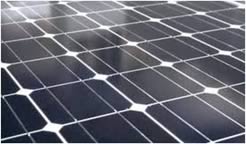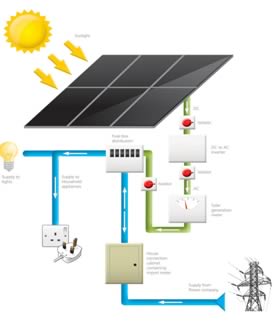SOLAR PV SYSTEMS |
Types of Solar PV Cells |
| In terms of the solar technology used, there are 3 main types of solar PV cells currently available. All 3 are built using silicon and each has its advantages and disadvantages. Our experienced installer will be able to help you choose which technology is best for your home and answer any questions or issues you may have. |
| |
Monocrystalline Solar PV Cells |
| Monocrystalline solar PV cells are produced from a single crystal of silicon (grown from highly pure molten silicon). This crystal is then cut into thin wafers between 0.2mm and 0.3mm thick, which then form the basis for the solar PV cell. These solar PV cells are the most efficient, however, they also tend to be the most expensive to manufacture. They are rigid and are mounted in a rigid frame for protection. |
|
 |
|
| |
Polycrystalline Solar PV Cells |
| Polycrystalline solar PV cells are made from a slice cut from a block of silicon, but unlike monocrystalline solar PV cells, polycrystalline solar PV cells contain multiple silicon crystals. This gives them a blue marbled appearance (rather than the much darker colour of monocrystalling solar PV cells). Polycrystalline solar PV cells are not as efficient than monocrystalline cells (typically outputs are lower). However, they are also less expensive to produce. These solar PV cells also need to be mounted in a rigid protective frame. |
|
 |
|
| |
Amorphous or Thin Film Solar PV Cells |
| Amorphous solar PV cells, are a type of ‘thin film solar cells’ and are made from a thin film of amorphous (non-crystalline) silicon. This can be placed on a wide range of different surfaces and, because the amorphous silicon layer is flexible, if placed on a flexible surface, then the whole solar PV cell can be flexible. These panels are the least expensive to produce but are also the least efficient. When purchasing amorphous solar PV cells, you should be aware that a characteristic of this type of solar PV cell is that the power output decreases over time – typically the largest decrease is in the first few months, after which the power output stabalises. This means that the quoted power output of amorphous solar PV cells should always refer to the maximum power after this stabalisation period. |
| |
Other Solar PV Cells |
| These are the 3 main types of solar PV cells currently available. However there are a variety of other solar PV technologies including various different forms of thin film solar PV cells made from different materials. As with all technologies, the market is moving very fast and new products are becoming available almost on a daily basis. For more information on the various types of solar PV cell, and help choosing the right technology to suit your budget and requirements, please do not hesitate to contact us on 0800 917 0331 |
| |
How the PV Panels work |
Solar PV Panels work by creating a DC electrical current. This DC power is then taken down through the building and connected into a AC/DC Inverter. This Inverter changes the elecrtrical current from DC to AC and allows this to then be connected into your electrical circuitry. A meter is installed after the Inverter to measure the amount of electrical current you are generating. The supply is then fed into the existing circuitry in your home.
The electricity is then able to follow 2 paths. The first path is to the existing electrical outlets in your home. In this way you are using the electricity generated Free of Charge and you do not have to pay for this. The second path is back through the exisitng incoming cables and into the National Grid system where the electricity is drawn of and used by anyone else connected to the system.
This is excessive electricity your are generating and is 'Sold off' to the grid. Typically, when you are out at work the amount of electricity generated exceeds your requirements and is therefore 'Sold off' or Exported to the Grid. |
|
 |
|
| |
Calculate your own system requirements |
| To run your own estimate click the link below, enter your postcode, change the estimated system losses to 10%, and select Free Standing for the system. The slope will be that of your roof, or 15° for a system mounted on a flat roof. The Azimuth is the orientation of your roof, so 0° is due South, -90° is East etc. |
|
| |
| |
Ecotec Green Heating Ltd
147, London Road, St. Albans, Herts. AL1 1TA
Phone Number 01727 842658
Phone Number 01582 842158 |
VAT Number GB 327 7477 10
Registration Number: 6742853
e-mail: ecotec.green@btinternet.com
www.ecotecgreenheating.com |
| |
|
|